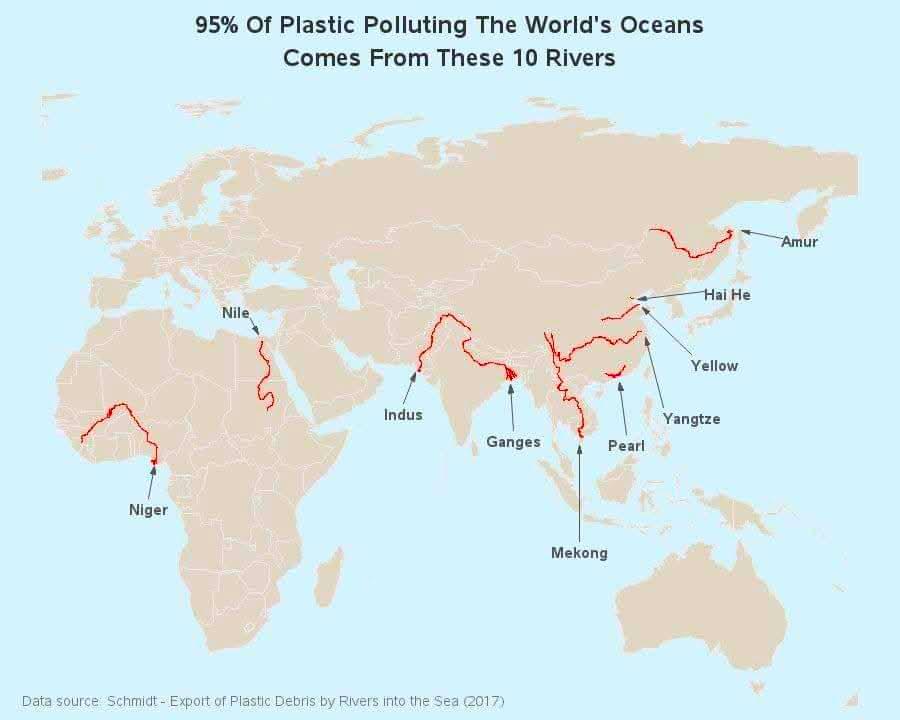Map of Rivers Contributing to Ocean Plastic


Marcus Rodriguez
Historical Geography Expert
Marcus Rodriguez specializes in historical cartography and geographic data analysis. With a background in both history and geography, he brings unique...
Geographic Analysis
What This Map Shows
This map illustrates a startling reality: 95% of ocean plastic pollution originates from just ten rivers around the globe. These rivers, often flowing through densely populated areas, serve as significant conduits for plastic debris, ultimately leading to our oceans. Understanding these waterways is crucial, as they not only shape our landscapes but also play a pivotal role in global environmental health. By focusing on these specific rivers, we can gain insights into the broader issue of ocean plastic pollution.
Deep Dive into Rivers and Their Role in Plastic Pollution
Rivers are vital arteries of our ecosystems, providing water, supporting biodiversity, and facilitating human activities. However, they also have the unfortunate role of acting as transport systems for waste, including plastic. The ten rivers highlighted in this map are: the Yangtze, Indus, Yellow, River Ganges, Nile, Mékong, Amazon, Lagos, and two others, each uniquely positioned to contribute to ocean plastic.
Interestingly, the flow patterns of these rivers often correlate with urban centers where waste management practices may be lacking or ineffective. For instance, the Yangtze River, the longest river in Asia, flows through some of China’s most populous regions, including Shanghai. Here, rapid industrialization and urban growth have led to increased waste production, much of which ends up in the river.
Another notable example is the Indus River in Pakistan, which faces similar challenges. With a large population relying on the river for water, the lack of adequate waste disposal systems results in significant plastic entering the riverbed.
The dynamics of these rivers are complex. They carry not only water but also sediment and organic material that can trap plastic debris. This phenomenon is especially pronounced in areas where riverbanks are eroded or where infrastructure is lacking, leading to increased plastic accumulation. The Mékong River, for example, is known for its rich biodiversity but is incredibly vulnerable to pollution due to rampant deforestation and agricultural runoff.
Moreover, rainfall patterns and seasonal floods can exacerbate the situation, sweeping plastics into the waterways and eventually into the ocean. This process is not just limited to the rivers mentioned; it’s a global phenomenon that can be observed in many river systems.
Regional Analysis
Examining the regions represented by these ten rivers reveals stark differences in plastic pollution sources and management practices. For instance, the Yangtze and Ganges flow through rapidly industrializing nations where economic growth often prioritizes development over environmental concerns. In contrast, the Nile, while also facing pollution issues, is affected by geopolitical factors, such as disputes over water rights which complicate waste management efforts.
Interestingly, the Amazon River, often celebrated for its biodiversity, also faces threats from plastic pollution, albeit from different sources, including deforestation and illegal mining activities that disrupt local ecosystems.
Furthermore, the Nile and Ganges have a historical significance that complicates modern environmental challenges. Both rivers are central to the livelihoods and cultures of millions, making it difficult to implement strict pollution controls without impacting local communities.
In regions like West Africa, where the Lagos River flows, urbanization has surged, resulting in inadequate waste management systems. Here, communities are often left grappling with the consequences of rapid growth without the infrastructure to support it.
Significance and Impact
The implications of plastic pollution are profound and multifaceted. Ocean plastics threaten marine life, disrupt ecosystems, and ultimately find their way back into the human food chain. What's fascinating is that addressing the problem requires a multifaceted approach, including improved waste management, public education, and international cooperation.
Current trends indicate that if we do not take action, the amount of plastic entering the oceans could triple by 2040. This projection highlights the urgency of addressing pollution at the source—namely, these ten rivers. By targeting initiatives to reduce plastic waste in these areas, we can make significant strides in mitigating ocean plastic pollution.
In conclusion, the map of the ten rivers contributing to ocean plastic serves as a crucial reminder of our interconnectedness with our environment. It challenges us to rethink our relationship with plastic and inspires action towards a cleaner, healthier ocean for future generations.
Visualization Details
- Published
- August 15, 2025
- Views
- 120
Comments
Loading comments...